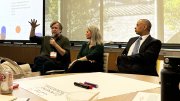Four years after Harvard and MIT launched edX, their online-course venture, in May 2012, MIT scholars have published “Online Education: A Catalyst for Higher Education Reforms,” a review of the field. Its lead authors—Karen Willcox, professor of aeronautics and astronautics, and Sanjay Sarma, Flowers professor of mechanical engineering and the institute’s vice president for open learning—look beyond the massive open online courses (MOOCs) that attracted such hoopla when edX was conceived. They focus instead on education and learning more broadly, and the implications for campus classrooms.
That emphasis is especially notable for two reasons. First, in the wake of MIT’s broad strategic embrace of new approaches to learning (see “What Modularity Means for MOOCs,” harvardmag.com/mit-edx-16), two-thirds of its undergraduates are reported to have taken courses that incorporate the edX interactive instructional software. Second, underwriting MOOC technology both for free use by self-motivated learners around the world and for its application in classrooms on this residential campus remains one of the foremost rationales for Harvard’s own investment (see Provost Alan Garber’s perspective in “Teaching and Learning: Taking Stock,” January-February, page 24). To date, it has been challenging to determine how to encourage such adoption, and to assess the effects.
The MIT authors emphasize that online courses will not supplant teachers: “[R]ather, we believe that the value of in-person education can be enhanced by blending in online experiences.” They outline a “dynamic digital scaffold” of “instrumented” learning, assisted by, for instance, interspersing videos with “interpolated testing”; spaced practice with material introduced days, weeks, and months earlier; designing problems to become more challenging as students’ skills broaden; and adapting course content to each learner’s needs. The aim is to “support teachers and allow them to free up time from conveying content to focus on high-value in-person interactions with students,” in a truly blended approach to learning.
To support such pedagogy, the MIT authors advocate systematic, interdisciplinary research on education, learning, cognition, and neuroscience. To bring those discoveries into teaching, they propose that universities cultivate as a profession the “learning engineer.” In contrast to current “learning designers,” who apply digital technologies to course content, they envision postdoctoral professionals with both Ph.D.-level command of a substantive discipline and immersion in learning science and technologies for classroom use.
These general findings resonate with other MOOC-related developments. For-profit MOOC distributor Coursera recently put its courses on a new platform so they can be offered nearly continuously, rather than only at limited, set intervals that mimic semester-based campus courses. President and co-founder Daphner Koller told The Chronicle of Higher Education that students who enroll in MOOCs “know their own mind [and] what they’re looking for” is very different from the current campus experience. “They’re looking for shorter, more-to-the-point modules of knowledge…for things that have direct relevance to the problems that they’re trying to solve.…” Because “MOOC students have the option to walk away,” they cannot be taught in the same way as on-campus learners. But the Coursera and edX technologies, of the sort the MIT report covers, suggest to Koller that “maybe what we should be providing to our on-campus students is actually more like what we’re providing to our MOOC students.”
As HarvardX continuously unveils new course offerings, attracting more users, their form is evolving. HarvardX’s faculty-driven courses are of general, or at least broad, interest; it is not competing with the Division of Continuing Education or the professional schools’ programs—all of which generate significant revenue. But HarvardX is experimenting; its eight-week “Plus” courses in biochemistry, contracts, and other subjects (with “Premium content. Deeper engagement”) feature limited enrollments, closer connections to fellow students and Harvard faculty members and teaching assistants, and branded credentials—at a cost of fees from $195 to $495.
The move toward collecting fees, primarily through explicitly vocationally focused courses, is broad. This fall, edX launched MicroMasters. Following an MIT pilot course in supply-chain management, more than a dozen other institutions have rolled out suites of four to 10 MOOCs, equivalent to one-quarter to one-half of the content for a master’s degree in subjects like artificial intelligence, Android program development, project management, or social work. Learners take those courses: for free; or paying for credentials certifying their completion of the work—after which they may apply for admission to each school’s master’s program, to complete formal degree work. If accepted, their course of study would be shortened, and made less expensive, because of the prior work online.
And in a step toward universities’ practice, edX has begun offering financial aid, discounting the fees charged for verified course certification; edX is nonprofit, and the assistance is being funded with philanthropic support.








